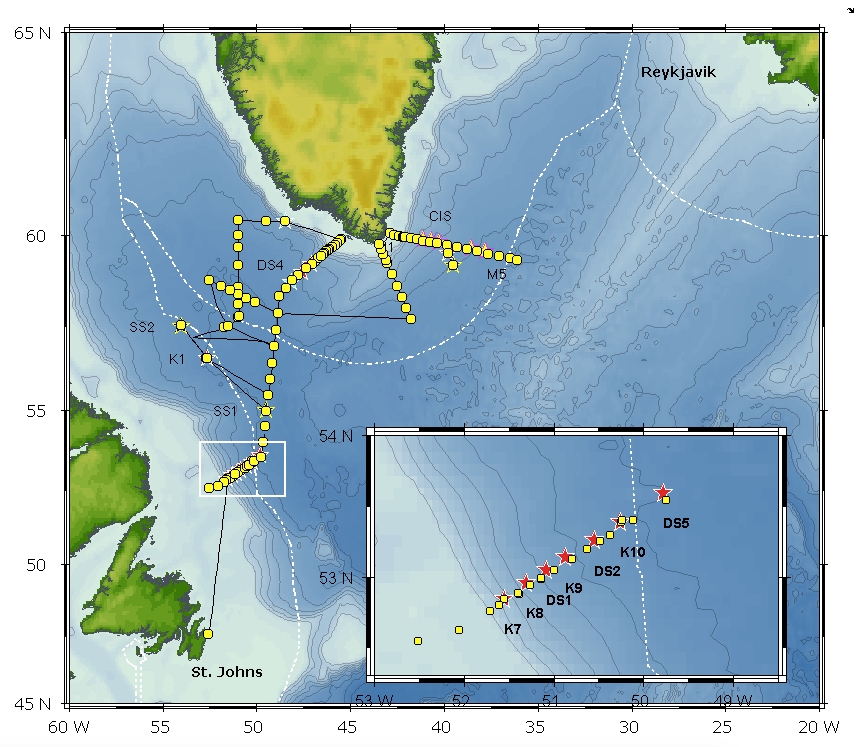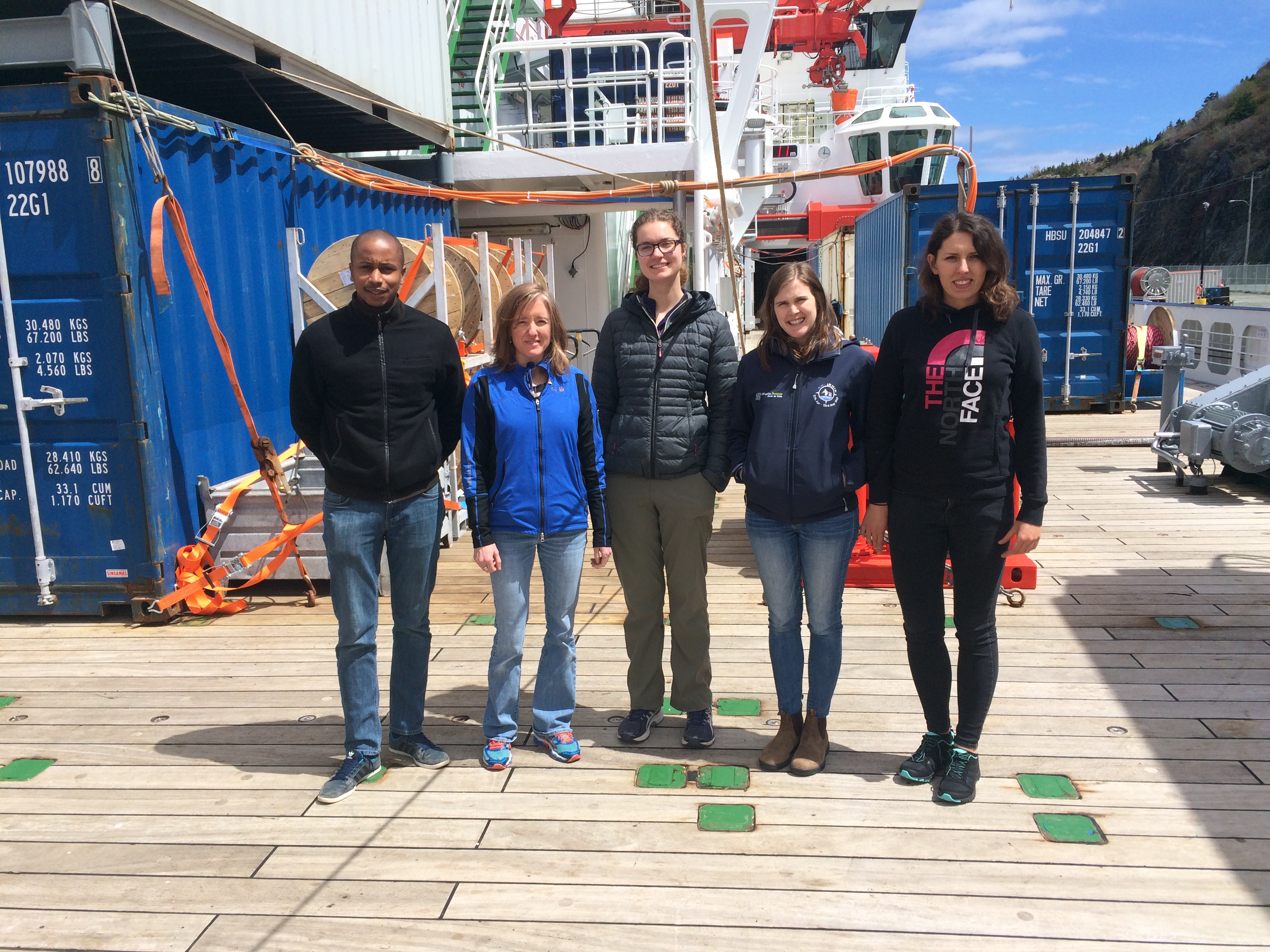News
» Go to news mainOnboard the R/V Merian: MSM74 ‑ Diving into the Biogeochemistry of the North Atlantic

Maria S. Merian - MSM74
May 25th – June 26th 2018
St. John’s, Canada to Reykjavik, Iceland
On May 25th 2018, the German scientific research vessel, the Maria S. Merian, led by chief scientist, Johannes Karstensen, departed St. John’s, Newfoundland with an international team of 21 scientists and technicians to begin a 5-week journey, ending in Reykjavik, Iceland. Among them were five researchers from Dalhousie University, who were onboard to sample and analyze waters in the Labrador and Irminger Seas. The CERC.OCEAN researchers on board were Dr. Dariia Atamanchuk, Claire Normandeau, and Liz Kerrigan who investigated oxygen, carbon and nutrients’ chemistry in this critical deep-water formation region of the ocean and Dr. Debany Fonseca Pereira Batista and Ciara Willis, who were looking at this area from a biological point of view, sampling for microbes and vitamins, as well as conducting nitrogen fixation experiments. The biology studies are part of the ongoing research of Dr. Julie LaRoche and Dr. Erin Bertrand groups at the Biology Department of Dalhousie.
All of the research conducted on the cruise by the CERC.OCEAN team is related to new projects supported by the Ocean Frontier Institute (OFI) and will contribute to OFI plans for establishment of a biogeochemical and microbiological observatory in the Labrador Sea. Dr. Batista (whose research is explained below) is the recipient of an OFI Postdoctoral Fellowship.
Members of the Dalhousie Biogeochemistry team (left to right: Dr. Debany Fonseca Pereira Batista, Claire Normandeau, Ciara Willis, Liz Kerrigan, and Dr. Dariia Atamanchuk)
Together the group from Dalhousie formed the biogeochemistry team on the cruise, while the rest of the cruise participants were primarily physical oceanographers working on the turning around of OSNAP moorings (www.o-snap.com), deploying BioARGO floats, and making full-depth CTD and velocity profiles along the cruise track. A majority of this group was made up of German researchers from GEOMAR along with the participants from Memorial University (MUN), Ecole Normale Supérieure de Paris (ENS), and National Oceanography Center (NOC), Southampton. Despite being on a German ship, with German scientists, crew, and food, it was a fairly international cruise!
Mooring Work:
The crew and scientists immediately got to work; with the ship’s arrival at the first mooring operations area off the coast of Labrador, a total of 18 mooring movements were carried out. This means winding 30 km of steel cable, handling more than 150 instruments, using 600 shackles and rings, and lowering more than 7,000 kg of anchor weights to the seabed. Instrument data from 2 years of deployment was recovered, new batteries installed and devices were set up for the new deployment.

MSM74 Cruise Track
Sampling and Data Analysis at Sea:
No time is wasted while onboard. Daytime mooring operations were often followed by nighttime CTD casts; that is why members of the CERC.OCEAN team, lead by Dr. Dariia Atamanchuk, often had to work through the night. The team brought four measurement systems onboard, and samples for oxygen, nutrients (nitrite, nitrate, phosphate, silicate, and ammonia), carbonate alkalinity, and isotopic total carbon (DIC-C13) were processed onboard, shortly after their collection. Only a handful of samples were shipped back to Dalhousie to be analyzed in the laboratory. Having the CERC.OCEAN Mobile Container Lab (read more about this unique lab, and its use on past crusies) on this cruise was a huge advantage and allowed a larger number of scientists to carry out their experiments/water analysis without interfering with the numerous mooring operations, which also required a lot of wet and dry lab space. This was new from past cruises on the Maria S. Merian (MSM54) and its presence was invaluable to the amount of work and data analysis that was accomplished onboard!
On the more biological side of the biogeochemistry team, an OFI postdoc, Debany Fonseca, transformed the scientific refrigerator (+6°C) into a laboratory. He used "incubators" – the large glass bottles are filled with seawater that is taken from different depths with the help of the CTD rosette. In the cold room, he was testing the reaction of the microorganisms which are living in the samples for changes in the supply of nutrients and the availability of light.
On the Hunt for Eddies:
Midway through the cruise, the team conducted surveys of several mesoscale eddies (diameter of ~100 km) or "whirls". These whirls are spinning water masses that vitally contribute to energy and material transport in the ocean. Eddies also play a major role in the Labrador Sea, transporting the water of the warm and saline boundary current into the central Labrador Sea. These features are often hard to capture and describe despite their crucial role in lateral transport of Greenland Current water into the Labrador Sea interior, as such we could not miss a chance to take some samples at specific locations
In the center of the cyclonic eddy, the GEOMAR team deployed two BioARGO drifters or floats. In addition to temperature and salinity, the two drifters also collect oxygen and the pH value of the water, a relatively new sensor on floats. Currently more than 3500 drifters are operational in the ocean - but only a few include a pH sensor. The distribution of deep drifters is constantly monitored and, when gaps open up, cruises like our MSM74 expedition are identified that can deploy new drifters. The CERC.OCEAN team carried out high-density sampling at the deployment locations of these floats that allows us to “calibrate” the newly deployed pH drifters before they enter their life-long journey through the oceans.
Sampling and Science at Sea:
Shortly after the eddy survey, we reached Cape Farewell, at the southern tip of Greenland, and continued further east towards Reykjanes Ridge. Five NOC moorings, also part of the O-SNAP array, were successfully recovered off the eastern Greenland coast. More CTD sections and sampling were carried out in-between the mooring operations to understand the water transport between the Irminger and the Labrador Seas.
On the fifth week into the cruise we started the last leg – a 3-day long transit towards Reykjavik, Iceland, our final destination. All moorings were turned around or recovered, BioARGOs were deployed and the last CTD cast was carried out. It was time to relax, catch-up on some sleep and prepare to meet the world outside the 97m-long research vessel.
Life at Sea:
Thankfully the people onboard made the trip go very smoothly, from working with the CTD rosette to ensure the best quality of delivered data and samples, to the daily science meetings and discussions on sampling strategies. In addition to long hours and lots of science, the scientists also enjoyed watching a very slow stream of the World Cup, participating in a ping pong, table soccer and dart tournament, and all the delicious food available onboard.
A big thanks to the scientists and crew onboard MSM74 for making this such a successful cruise!
How would you describe a month of oceanographic expedition at sea? Check the video below!
Recent News
- Recap of ASITA 2024 Conference
- ASITA 2024 Conference
- Happy World Ocean Day! + CMOS congress 2023 recap
- Upcoming presentations by CERC.OCEAN lab at the CMOS 57th congress
- UPDATED: List of Instrumentation and Analytical Services
- Field Report: Exploratory Study of nitrogen cycling at the Lagoon Lagos
- Marine Robots – Back in Action at OHMSETT
- Spotlight of the month: Adriana Reitano


